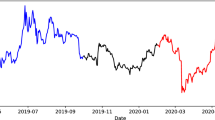Abstract
Derivatives on the Chicago Board Options Exchange volatility index have gained significant popularity over the last decade. The pricing of volatility derivatives involves evaluating the square root of a conditional expectation which cannot be computed by direct Monte Carlo methods. Least squares Monte Carlo methods can be used, but the sign of the error is difficult to determine. In this paper, we propose a new model-independent technique for computing upper and lower pricing bounds for volatility derivatives. In particular, we first present a general stochastic duality result on payoffs involving convex (or concave) functions. This result also allows us to interpret these contingent claims as a type of chooser options. It is then applied to volatility derivatives along with minor adjustments to handle issues caused by the square root function. The upper bound involves the evaluation of a variance swap, while the lower bound involves estimating a martingale increment corresponding to its hedging portfolio. Both can be achieved simultaneously using a single linear least square regression. Numerical results show that the method works very well for futures, calls and puts under a wide range of parameter choices.

Similar content being viewed by others
References
Whaley, R.E.: Derivatives on market volatility: hedging tools long overdue. J. Deriv. 1(1), 71–84 (1993)
Grünbichler, A., Longstaff, F.A.: Valuing futures and options on volatility. J. Bank. Finance 20(6), 985–1001 (1996)
Detemple, J., Osakwe, C.: The valuation of volatility options. Eur. Finance Rev. 4(1), 21–50 (2000)
Zhang, J.E., Zhu, Y.: VIX futures. J. Futures Mark. 26(6), 521–531 (2006)
Lian, G.H., Zhu, S.P.: Pricing VIX options with stochastic volatility and random jumps. Decis. Econ. Finance 36(1), 71–88 (2013)
Sepp, A.: VIX option pricing in a jump-diffusion model. Risk Magazine, April 2008, pp. 84–89
Baldeaux, J., Badran, A.: Consistent modelling of VIX and equity derivatives using a 3/2 plus jumps model. Appl. Math. Finance 21(4), 299–312 (2014)
Cont, R., Kokholm, T.: A consistent pricing model for index options and volatility derivatives. Math. Finance 23(2), 248–274 (2013)
Carriere, J.F.: Valuation of the early-exercise price for options using simulations and nonparametric regression. Insur. Math. Econ. 19(1), 19–30 (1996)
Longstaff, F.A., Schwartz, E.S.: Valuing American options by simulation: a simple least-squares approach. Rev. Financ. stud. 14(1), 113–147 (2001)
Rogers, L.C.: Monte Carlo valuation of American options. Math. Finance 12(3), 271–286 (2002)
Haugh, M.B., Kogan, L.: Pricing American options: a duality approach. Oper. Res. 52(2), 258–270 (2004)
Andersen, L., Broadie, M.: Primal-dual simulation algorithm for pricing multidimensional American options. Manag. Sci. 50(9), 1222–1234 (2004)
Schoenmakers, J., Zhang, J., Huang, J.: Optimal dual martingales, their analysis, and application to new algorithms for Bermudan products. SIAM J. Financ. Math. 4(1), 86–116 (2013)
Joshi, M., Tang, R.: Effective sub-simulation-free upper bounds for the Monte Carlo pricing of callable derivatives and various improvements to existing methodologies. J. Econ. Dyn. Control 40, 25–45 (2014)
De Marco, S., Henry-Labordere, P.: Linking vanillas and VIX options: a constrained martingale optimal transport problem. SIAM J. Financ. Math. 6(1), 1171–1194 (2015)
Guyon, J., Menegaux, R., Nutz, M.: Bounds for VIX futures given S&P 500 smiles. (to appear in Finance and Stochastics, 2016)
Rockafellar, R.T.: Convex Analysis. Princeton university press, Princeton (2015)
Fries, C.P.: Foresight bias and suboptimality correction in MonteCarlo pricing of options with early exercise. In: Progress in Industrial Mathematics at ECMI 2006, pp. 645–649. Springer, Berlin (2008)
Acknowledgements
The Centre for Quantitative Finance and Investment Strategies has been supported by BNP Paribas.
Author information
Authors and Affiliations
Corresponding author
Rights and permissions
About this article
Cite this article
Guo, I., Loeper, G. Pricing Bounds for Volatility Derivatives via Duality and Least Squares Monte Carlo. J Optim Theory Appl 179, 598–617 (2018). https://doi.org/10.1007/s10957-017-1168-2
Received:
Accepted:
Published:
Issue Date:
DOI: https://doi.org/10.1007/s10957-017-1168-2




